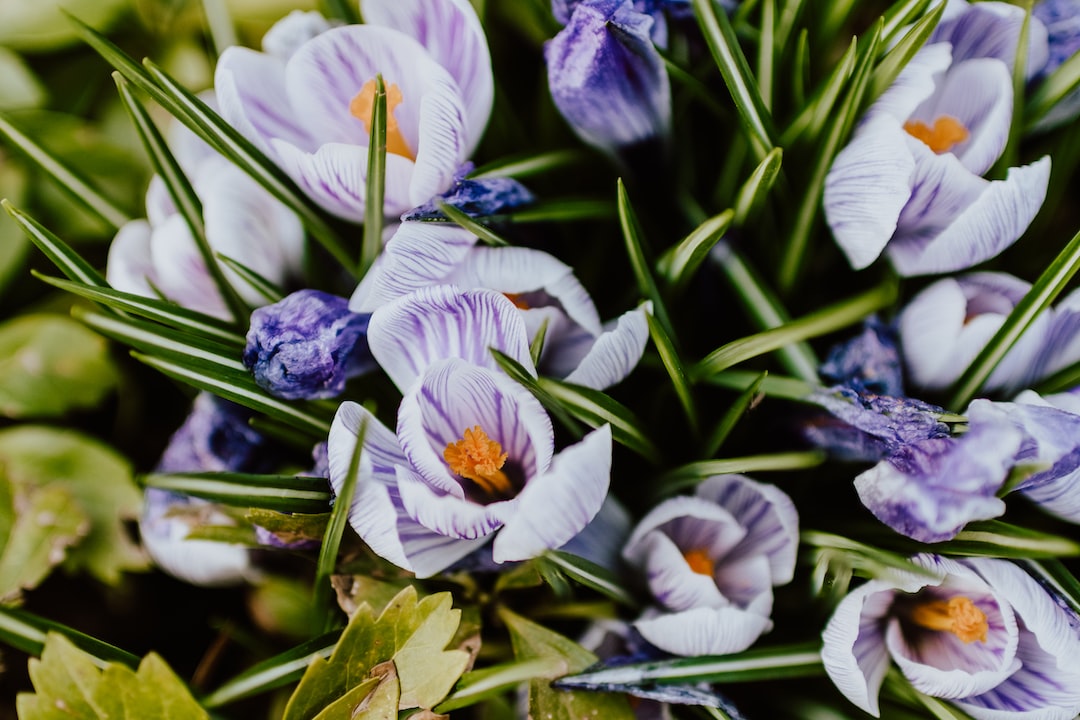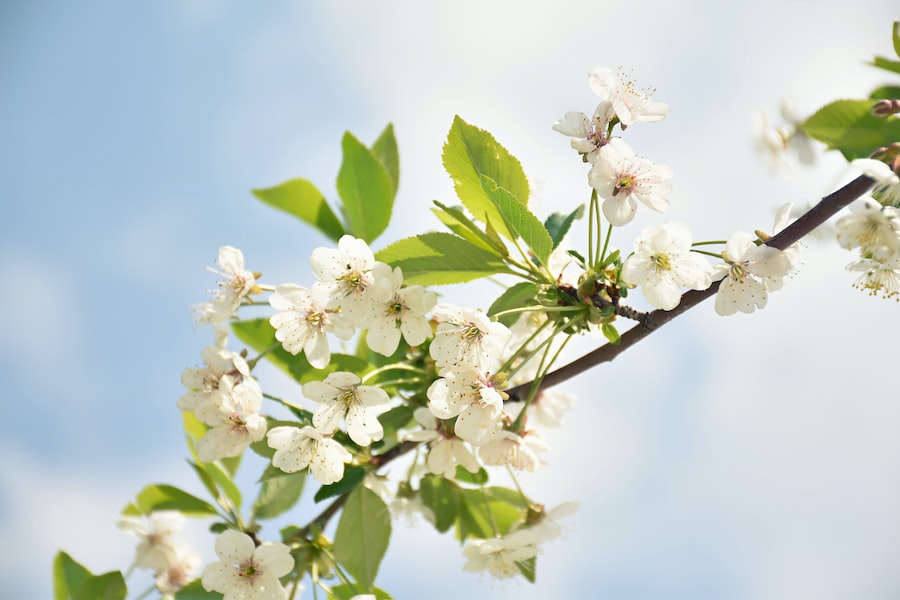Unlocking the Secret to Blooming Peace Lilies: Tips and Tricks for a Flourishing Houseplant

Peace lilies, also known as Spathiphyllum, are a popular choice for houseplants due to their elegant appearance and easy care requirements. These plants are native to the tropical regions of the Americas and have been cultivated for centuries. They are known for their large, glossy green leaves and striking white flowers that resemble a peace sign, hence their name.
The popularity of peace lilies can be attributed to their ability to thrive in low light conditions, making them ideal for indoor spaces. They are also known for their air-purifying properties, as they can remove toxins such as formaldehyde and benzene from the air. This makes them a great choice for improving indoor air quality and creating a healthier living environment.
Key Takeaways
- Peace lilies are a popular houseplant due to their beautiful white flowers and air-purifying qualities.
- Understanding the growth cycle of peace lilies is important for proper care and maintenance.
- Choosing the right soil and pot is crucial for the health and growth of your peace lily.
- Proper watering and drainage are essential for preventing root rot and maintaining healthy foliage.
- Peace lilies require bright, indirect light and should be kept out of direct sunlight.
Understanding the Growth Cycle of Peace Lilies
To properly care for peace lilies, it is important to understand their growth cycle. Peace lilies go through several stages of growth, including sprouting, leaf development, flowering, and dormancy.
During the sprouting stage, peace lilies will send up new shoots from the soil. These shoots will eventually develop into leaves. It is important to provide adequate water and light during this stage to promote healthy growth.
Once the leaves have fully developed, peace lilies will enter the flowering stage. This is when the iconic white flowers will bloom. The flowers can last for several weeks before fading away. It is important to note that not all peace lilies will bloom at the same time, so it is normal for some plants to be in different stages of flowering.
After the flowering stage, peace lilies will enter a period of dormancy. During this time, growth will slow down and the plant may appear less vibrant. It is important to continue providing proper care during this stage to ensure the plant remains healthy.
Factors that can affect the growth cycle of peace lilies include temperature, humidity, and light levels. Peace lilies prefer temperatures between 65-85°F (18-29°C) and high humidity levels. They also thrive in bright, indirect light, but can tolerate lower light conditions.
Choosing the Right Soil and Pot for Your Peace Lily
Choosing the right soil and pot for your peace lily is crucial for its overall health and growth. Peace lilies prefer a well-draining soil that retains moisture but does not become waterlogged. A good potting mix for peace lilies should be rich in organic matter and have good drainage properties.
When selecting a pot for your peace lily, it is important to choose one that has drainage holes at the bottom. This will allow excess water to drain out and prevent the roots from sitting in water, which can lead to root rot. The pot should also be large enough to accommodate the plant’s root system, with some room for growth.
The Importance of Watering and Drainage for Peace Lilies
| Metrics | Importance |
|---|---|
| Watering frequency | Regular watering is crucial for peace lilies to thrive. Overwatering can lead to root rot, while underwatering can cause the leaves to wilt and turn yellow. |
| Water quality | Peace lilies are sensitive to chemicals and minerals in tap water. Using distilled or filtered water can prevent leaf browning and tip burn. |
| Drainage | Good drainage is essential to prevent water from accumulating in the soil and causing root rot. Adding perlite or sand to the soil mix can improve drainage. |
| Humidity | Peace lilies prefer high humidity levels. Misting the leaves or placing a tray of water near the plant can increase humidity and prevent leaf browning. |
Proper watering and drainage are essential for the health of peace lilies. These plants prefer to be kept evenly moist, but not overly wet. Overwatering can lead to root rot, while underwatering can cause the leaves to wilt and turn yellow.
To water your peace lily properly, wait until the top inch of soil feels dry to the touch before watering. When watering, thoroughly saturate the soil until water drains out of the bottom of the pot. Allow any excess water to drain away completely before placing the plant back in its saucer or decorative pot.
In addition to proper watering, good drainage is crucial for peace lilies. If the pot does not have drainage holes, it is important to remove any excess water from the saucer or decorative pot after watering. Standing water can lead to root rot and other fungal diseases.
Light Requirements for Peace Lilies: Finding the Sweet Spot
Peace lilies thrive in bright, indirect light. They can tolerate lower light conditions, but may not flower as prolifically. It is important to find the sweet spot when it comes to light conditions for peace lilies.
Ideally, peace lilies should be placed near a window that receives bright, indirect light. Direct sunlight can scorch the leaves, so it is best to avoid placing them in direct sunlight. If you do not have a window that provides enough light, you can supplement with artificial lighting, such as fluorescent or LED grow lights.
If you notice that your peace lily’s leaves are turning yellow or brown, it may be an indication that it is receiving too much light. On the other hand, if the leaves are dark green and the plant is not flowering, it may be an indication that it is not receiving enough light. Adjusting the light conditions accordingly can help promote healthy growth and flowering.
Fertilizing Your Peace Lily: Dos and Don’ts

Fertilizing your peace lily is important for providing it with the necessary nutrients for growth and flowering. However, it is important to follow some dos and don’ts when it comes to fertilizing peace lilies.
Do fertilize your peace lily during the growing season, which is typically spring and summer. Use a balanced, water-soluble fertilizer diluted to half strength. Apply the fertilizer every 4-6 weeks to provide a steady supply of nutrients.
Don’t over-fertilize your peace lily. Excessive fertilization can lead to salt buildup in the soil, which can damage the roots and hinder growth. It is important to follow the instructions on the fertilizer packaging and avoid applying more than recommended.
Pruning and Propagating Peace Lilies: Keeping Them Healthy
Pruning and propagating peace lilies are important tasks for keeping them healthy and promoting new growth.
To prune your peace lily, remove any dead or yellowing leaves by cutting them off at the base. This will help improve the overall appearance of the plant and prevent the spread of diseases. You can also trim back any leggy or overgrown stems to encourage bushier growth.
Propagating peace lilies can be done through division or stem cuttings. To divide a peace lily, carefully remove it from its pot and separate the root ball into smaller sections. Each section should have at least one healthy shoot and a portion of the root system. Plant the divisions in separate pots with fresh potting soil and water thoroughly.
To propagate peace lilies from stem cuttings, select a healthy stem with several leaves and cut it just below a leaf node. Place the cutting in a glass of water or a small pot filled with moist potting soil. Keep the cutting in a warm, humid environment and wait for roots to develop before transplanting it into its own pot.
Common Problems and Solutions for Peace Lilies
Like any houseplant, peace lilies can face common problems such as pests, diseases, and environmental stressors. It is important to be aware of these issues and know how to address them.
One common problem for peace lilies is spider mites. These tiny pests can infest the leaves and cause them to turn yellow and develop webbing. To treat spider mites, wash the leaves with a mild soap and water solution or use an insecticidal soap. It is also important to increase humidity levels around the plant to discourage further infestation.
Another common issue for peace lilies is root rot, which is caused by overwatering or poor drainage. To prevent root rot, ensure that the pot has drainage holes and allow the soil to dry out slightly between waterings. If root rot has already occurred, it may be necessary to repot the plant in fresh soil and trim away any affected roots.
Environmental stressors such as low humidity, temperature fluctuations, and drafts can also cause problems for peace lilies. To prevent these issues, place the plant in a location with stable temperature and humidity levels. Avoid placing it near air vents or drafty windows.
Decorating with Peace Lilies: Displaying Them in Your Home
Peace lilies can be a beautiful addition to any home decor. They can be displayed in various ways to enhance the aesthetic appeal of your living space.
One popular way to display peace lilies is in decorative pots or planters. Choose pots that complement your home decor and place them in prominent areas such as entryways, living rooms, or dining rooms. You can also group several peace lilies together for a more dramatic effect.
Another creative way to display peace lilies is by hanging them in macrame plant hangers or placing them on wall-mounted shelves. This can add a unique touch to your home decor and make use of vertical space.
Additionally, peace lilies can be used as centerpieces for special occasions or events. Their elegant white flowers can create a stunning focal point on dining tables or mantels.
Enjoying the Beauty and Benefits of Peace Lilies
In conclusion, peace lilies are a popular houseplant choice due to their elegant appearance and easy care requirements. They have a rich history and have been cultivated for centuries. Having peace lilies in your home can provide numerous benefits, including improved indoor air quality and a touch of natural beauty.
Understanding the growth cycle of peace lilies is important for providing proper care. Factors such as soil, pot selection, watering, light requirements, and fertilizing should be considered to ensure the health and growth of the plant. Pruning and propagating peace lilies are also important tasks for keeping them healthy and promoting new growth.
Common problems such as pests, diseases, and environmental stressors can be addressed with proper care and attention. By decorating with peace lilies, you can enhance the aesthetic appeal of your home and enjoy the beauty and benefits they provide.
In conclusion, peace lilies are a versatile and rewarding houseplant that can bring beauty and health benefits to any home. With proper care and attention, these plants can thrive and provide years of enjoyment. So why not add a peace lily to your indoor garden today?
If you’re wondering how to get your peace lily to bloom, you might find this article on Lawn World’s website helpful. They provide expert tips and advice on caring for indoor plants, including specific guidance on encouraging peace lilies to produce beautiful blooms. Check out their comprehensive sitemap to easily navigate through their extensive collection of articles and find the information you need to create a thriving indoor garden.



